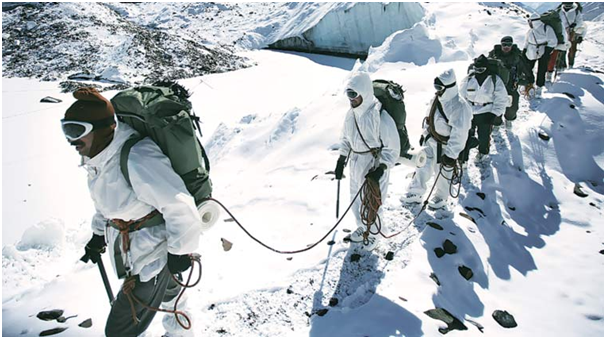Siachen Kills Again
Indian Army at Siachen: braving inhospitable conditions
NEW DELHI: Even as rescue teams scan the snow covered mountains of the Siachen glacier for the ten Indian soldiers missing since being hit by an avalanche a day ago, the incident brings home again the futility of the costly dispute between India and Pakistan.
Siachen was occupied by Indian troops just four days before the Pakistan Army that was heading in the same direction in April 1984. Operation Meghdoot was a major strategic success and recognised as such by the world at the time. Siachen then became the “highest battleground” in the world for both India and Pakistan with intermittent wars taking a loss of life, even as hundreds of soldiers on both sides were claimed by the hazardous terrain, avalanches and extremely hostile weather conditions. A ceasefire in 2003 brought some relief but it took several years more for the Indian Army to overcome the climatic challenges with special equipment and training helping the process of reducing losses.
The costs incurred are huge with Rs five crores projected as a conservative estimate for just maintaining the 20000 odd soldiers stationed at Siachen.
Siachen became one of the eight disputes identified by the foreign secretaries of India and Pakistan when both moved towards a peace dialogue. The Indian Army was clear from the very beginning of the composite dialogue that it was not for a negotiated solution as it had the upper military hand and was not willing to lose it. As the Defence Chiefs made it repeatedly clear to successive Prime Ministers and governments the Army would not sign on the dotted line for three basic reasons:
1. militarily and strategically the Indian Army was at vantage point; and believes in the fact that if India had not occupied Siachen, then Pakistan from the West and China from the East would have a stranglehold over the Karakorum Pass.
2. it had already incurred the maximum losses, and over the years had overcome as far as possible the hostile weather conditions;
3. Pakistan could not be trusted (more so after Kargil) and if the Indian Army was made to withdraw, reoccupying the heights if so required at some point would entail huge losses and expenditure.
It is true, according to information with The Citizen from 2006, that India and Pakistan had moved fairly close towards a solution. The Indian military condition to delineate the maps, and mark the positions held by the two sides in close detail had been reportedly agreed to but it was not clear how the two governments had resolved the inherent differences about the actual boundaries of conflict at Siachen. There is a major difference in the maps of both, with Pakistan not conceding the territory it lost to the Indian Army in 1984. Sources claimed that this had been resolved, but there was of course no official confirmation of the same.
Former Pakistan Foreign Minister Khurshid Kasuri claimed while in office, and later that both sides had come very close to resolving Siachen. And that the Indian objections had been dealt with in talks between the two sides to a level where “political will” could move to seal the pact. This was as far back as 2005-2006 when he insisted, “"As a foreign minister of Pakistan, I know we are very close to an agreement. I will not go into details. It depends on political will and I hope that the PM and the (new) foreign minister of India will show that political will.” The Indian military was dead set against it largely because as one of the defence chiefs at the time told this writer, “we have lost a lot of men and now just as we have reduced the losses to acceptable limits we are being told about these negotiations with Pakistan. Fine, we will go if the political leadership wants us to, but then it should also give a guarantee that if the Pakistan Army moves to occupy the heights then don’t ask the Indian Army to go back up there. The losses then will be unimaginable as against the holding operation now.”
Former Prime Minister Manmohan Singh became the first PM to visit Siachen and hinted at it being made the area being made a mountain of peace only to find that there were no takers in the defence establishment, including then Defence Minister A.K.Antony.
The rescue teams, according to news just coming in, have failed to find the missing Indian soldiers joining the long line of those killed by avalanches, frostbite and other conditions in what India and Pakistan have converted into a battlezone.





